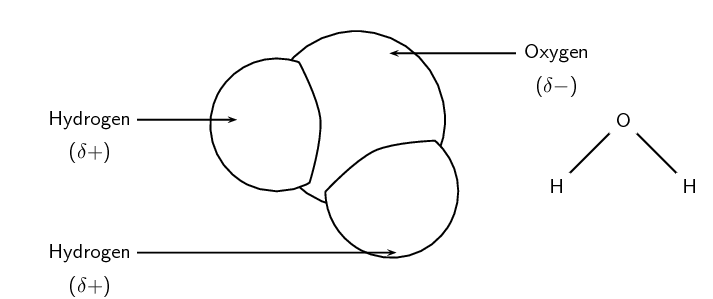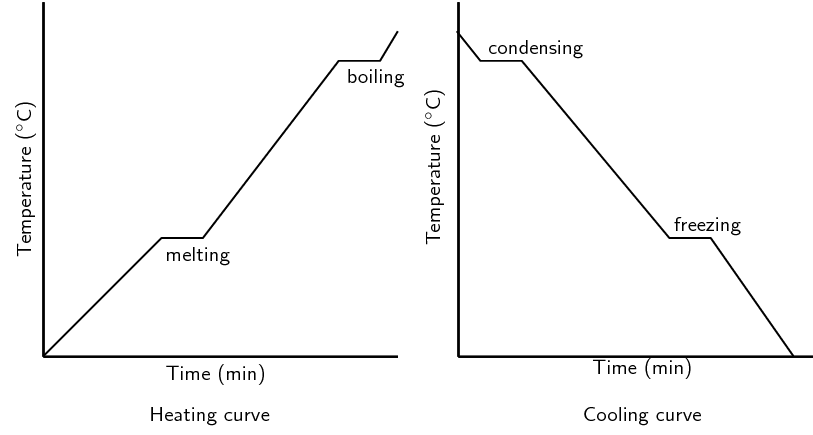What property of ice cubes allows them to float in the water?
Ice cubes are less dense than liquid water. Water has a less dense solid phase than solid water.
|
Previous
4.1 Intermolecular and interatomic forces
|
Next
4.3 Chapter summary
|
We will now look at how intermolecular forces apply to a very special liquid. This section shows how the knowledge of intermolecular forces can be applied to the case of water.
In many ways, water behaves very differently from other compounds. These properties are directly related to the microscopic structure of water, and more specifically to the shape of the molecule and its polar nature, and to the intermolecular forces that hold water molecules together.
There are about \(\text{55,5}\) \(\text{mol}\) of water in \(\text{1}\) \(\text{L}\). This is equivalent to \(\text{3,34} \times \text{10}^{\text{25}}\) molecules of water. That's a lot of water molecules!
In the previous chapter you learnt about molecular shape and polarity. Water has two hydrogen atoms around a central oxygen atom. The central oxygen atom also has two lone pairs of electrons. This gives water a bent (or angular) shape. It also means that water is polar since the two hydrogen atoms are not parallel to each other and so do not cancel out the bond polarity (refer back to the previous chapter on molecular shape). We can see this in the following image:

Water molecules are held together by hydrogen bonds. Hydrogen bonds are a much stronger type of intermolecular force than those found in many other substances, and this affects the properties of water.

We will now look at a few of the properties of water.
Specific heat
Specific heat is the amount of heat energy that is needed to increase the temperature of a unit mass of a substance by one degree.
Water has a high specific heat, meaning that a lot of energy must be absorbed by water before its temperature changes.
You have probably observed this phenomenon if you have boiled water in a pot on the stove. The metal of the pot heats up very quickly, and can burn your fingers if you touch it, while the water may take several minutes before its temperature increases even slightly. How can we explain this in terms of hydrogen bonding? Remember that increasing the temperature of a substance means that its particles will move more quickly. However, before they can move faster, the intermolecular forces between them must be disrupted. In the case of water, these forces are strong hydrogen bonds, and so a lot of energy is needed just to break these, before the particles can start moving further apart.
Absorption of infra-red radiation
Water is able to absorb infra-red radiation (heat) from the sun. As a result of this, the oceans and other water bodies act as heat reservoirs, and are able to help moderate the Earth's climate.
It is the high specific heat of water and its ability to absorb infra-red radiation that allows water to regulate the climate. Towns close to the sea often have less extreme temperatures than inland towns due to the oceans ability to absorb the heat.
Melting point and boiling point
The melting point of water is \(\text{0}\) \(\text{℃}\) and its boiling point is \(\text{100}\) \(\text{℃}\) (at standard pressure or \(\text{0,987}\) \(\text{atm}\)). This large difference between the melting and boiling point is very important because it means that water can exist as a liquid over a large range of temperatures. (This temperature range is only large in the world around us, if we look at space and the universe then this is a very narrow temperature range.)
When the boiling point of water is measured at sea level (e.g. towns like Cape Town and Durban), it is often very close to \(\text{100}\) \(\text{℃}\) since the atmospheric pressure is almost the same as the standard pressure. If you measure the boiling point of water in a town at a higher altitudes (e.g. Johannesburg or Polokwane) it will have a slightly lower boiling point.
In grade \(\text{10}\) you studied the heating and cooling curve of water. This is given below.

High heat of vaporisation
Heat of vaporisation is the energy that is needed to change a given quantity of a substance into a gas.
The strength of the hydrogen bonds between water molecules also means that it has a high heat of vaporisation. “Heat of vaporisation” is the heat energy that is needed to change water from the liquid to the gas phase. Because the forces between molecules are strong, water has to be heated to \(\text{100}\) \(\text{℃}\) before it changes phase. At this temperature, the molecules have enough energy to break the intermolecular forces that hold the molecules together. The heat of vaporisation for water is \(\text{40,65}\) \(\text{kJ·mol$^{-1}$}\).
It is very important for life on earth that water does have a high heat of vaporisation. Can you imagine what a problem it would be if water's heat of vaporisation was much lower? All the water that makes up the cells in our bodies would evaporate and most of the water on earth would no longer be able to exist as a liquid!
Less dense solid phase
Another unusual property of water is that its solid phase (ice) is less dense than its liquid phase. You can observe this if you put ice into a glass of water. The ice doesn't sink to the bottom of the glass, but floats on top of the liquid. This phenomenon is also related to the hydrogen bonds between water molecules. While other materials contract when they solidify, water expands. The ability of ice to float as it solidifies is a very important factor in the environment. If ice sank, then eventually all ponds, lakes, and even the oceans would freeze solid as soon as temperatures dropped below freezing, making life as we know it impossible on Earth. During summer, only the upper few metres of the ocean would thaw. Instead, when a deep body of water cools, the floating ice insulates the liquid water below, preventing it from freezing and allowing life to exist under the frozen surface.
Antarctica, the “frozen continent”, has one of the world's largest and deepest freshwater lakes. And this lake is hidden beneath \(\text{4}\) \(\text{km}\) of ice! Lake Vostok is \(\text{200}\) \(\text{km}\) long and \(\text{50}\) \(\text{km}\) wide. The thick, glacial blanket of ice acts as an insulator, preventing the water from freezing.
It should be clear now, that water is an amazing compound, and that without its unique properties, life on Earth would definitely not be possible.
Explain why water takes a long time to heat up, but the pot that you are heating it in gets hot quickly.
We are asked why water takes a long time to heat up compared to the pot you are heating it in. The property that applies here is the high specific heat of water. The other properties of water do not apply here since we are comparing the pot to the water and the pot is not changing phase.
Water has a high specific heat, while the metal that the pot is made of does not. The metal pot needs less energy to heat it up and so it gets hotter faster. Water needs a lot of energy to change its temperature and so it takes longer to get hot.
An experiment for informal assessment is included in this chapter. This experiment is very similar to the one on intermolecular forces. In this experiment learners focus on the properties of water. This is a good experiment to do to guide learners in understanding the properties of water.
When working with Bunsen burners learners should ensure that loose clothing is tucked away and long hair is tied back. As always with chemistry experiments you should open all the windows to ensure a well ventilated room. At the end of the experiment check that all Bunsen burners are turned off.
If learners leave the beaker of water on the Bunsen burner for to long and the water starts to boil or steam is observed, then make sure the learners do not touch the beaker as they will be burn themselves.
To investigate the properties of water.
Pour about \(\text{100}\) \(\text{ml}\) of water into a glass beaker.
Place the beaker on a stand and heat it over a Bunsen burner for about a minute.
After this time, carefully touch the side of the beaker (Make sure you touch the glass very lightly because it will be very hot and may burn you!). Then test the temperature of the water.
Note what happens when you place ice into water.
Carefully layer water and carbon tetrachloride in a test-tube. Which substances floats on top? Try adding the water first and the carbon tetrachloride second and then the other way around. Repeat with oil and ethanol.
Dissolve the different solid substances in water. Observe how much of each solid (if any) dissolves.
Record all your results in the following table.
|
Property |
Observation |
|
Temperature |
|
|
Ice in water |
|
|
Carbon tetrachloride and water |
|
|
Oil and water |
|
|
Ethanol and water |
|
|
Solubility |
You should find that the glass beaker heats up faster than the water. You should also find that water is more dense in the liquid phase than in the solid phase. Water floats on some liquids and other liquids float on water. Water is a good solvent for polar and ionic substances.
Carry out some research into: water bags on cars, clay pots and carafes for water and safe or “cool” rooms to keep food cool. Find out which people groups use these things and how the properties of water help in each case.
Hope returns home from school on a hot day and pours herself a glass of water. She adds ice cubes to the water and notices that they float on the water.
What property of ice cubes allows them to float in the water?
Ice cubes are less dense than liquid water. Water has a less dense solid phase than solid water.
Briefly describe how this property affects the survival of aquatic life during winter.
If the ice did not float on top of the water then all bodies of water would freeze from the bottom up. This would mean that aquatic life would not be able to survive through the cold winters as there would be no habitat for them.
Which properties of water allow it to remain in its liquid phase over a large temperature range? Explain why this is important for life on earth.
High boiling point and low melting point. Water has strong hydrogen bonds between molecules. These bonds require a lot of energy before they will break. This leads to water having a higher boiling point than if there were only weaker dipole-dipole forces. Water also has a high specific heat. If water did not have such a large range in which it is a liquid, bodies of water would freeze over faster, destroying the life in them. Also if the boiling point of water was lower, then all the water could evaporate on a hot day, which would cause all life to die.
Which property of water allows the oceans to act as heat reservoirs? What effect does this have on the Earths climate?
Water is able to absorb infrared radiation (heat) from the sun. This heat energy is stored in the oceans. Without this effect, the heat from the sun would cause the daytime temperatures on the Earth to become unbearably hot.
|
Previous
4.1 Intermolecular and interatomic forces
|
Table of Contents |
Next
4.3 Chapter summary
|